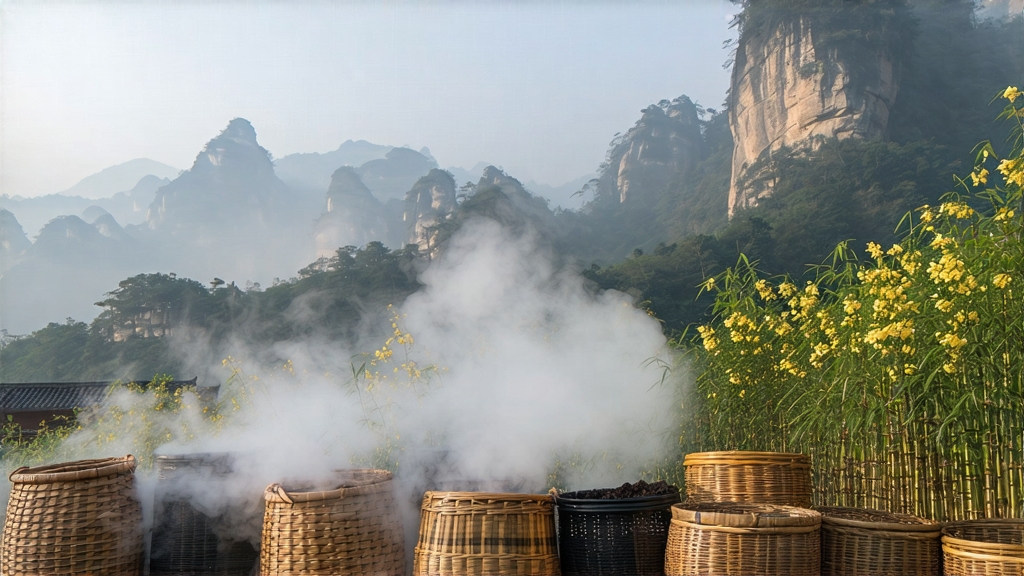
Tucked high in the mist-veiled Dabie Mountains of western Anhui Province, Huoshan Huangya has quietly defied the rush of modern tea commerce for more than seven centuries. While green tea grabs headlines and pu-erh fills investment portfolios, this micro-lot yellow tea survives as a living fossil of Chinese court taste, its downy buds still hand-roasted in the same bamboo baskets that once fed the imperial courier stations of the Ming Dynasty. To understand Huoshan Huangya is to step into a slower China—one measured not in harvest tonnes but in the precise timing of a single overnight “menhuang,” the gentle suffocation that turns fresh leaf from jade to antique gold without ever allowing it to oxidize into blackness.
History: From Mountain Shrine to Forbidden City
Local gazetteers record that Buddhist monks at the Bamboo Forest Monastery began pressing tender buds into cakes during the Tang era (618-907), but the tea first enters national chronicles in 1495 when the Hongzhi Emperor levied it as “gong cha,” tribute tea. Each spring, magistrates sealed 1.2 kg of the smallest buds in tin-lined canisters, then galloped 1,100 km to Beijing along post-roads whose relay stations still bear horse-hoof grooves. By the Qing, the quota had risen to 14 kg, and pickers were required to bathe in mountain water, chew cloves, and wear cotton gloves to avoid tainting the leaf. When the imperial system collapsed in 1911, demand evaporated; the gardens reverted to subsistence vegetable plots. Not until 1972 did a state delegation rediscover ancient shrubs hidden behind a waterfall, initiating the slow renaissance that today supplies fewer than eight tonnes a year—less than a single hour’s output from a commercial green-tea factory.
Terroir: Why the Dabie Micro-Climate Matters
Huoshan County straddles 31° N at elevations between 300 and 900 m. Granitic soils, rich in potassium and fluorine, drain rapidly, forcing roots to dive deep for water that has percolated through bamboo and pine litter. The region’s hallmark is a 40-day spring fog: each dawn, warm Qiandaohu lake air meets cold mountain downdrafts, creating a 6 °C diurnal swing that stalls photosynthesis. The stress concentrates amino acids—especially L-theanine—while catechins remain comparatively low, giving the tea its hallmark sweet brothiness without the grassy bite common to early-harvest greens. Only three villages—Jinji Mountain, Foziling, and Taiyang—possess the right altitude, humidity, and slope orientation; leaf picked even 200 m lower fails to develop the inner “golden heart” visible when a dried bud is back-lit.
Cultivars: Two Lineages, One Cup
All true Huoshan Huangya derives from seed-propagated descendants of the original “Huoshan Qunti” landrace, a small-leaf, slow-budding species that botanists classify as Camellia sinensis var. sinensis forma huoshanensis. Within this population, two phenotypes are now propagated:
- Jinzhong: “golden bell”—round, plump buds with a high starch reserve that caramelizes during menhuang, yielding cocoa notes.
- Yanzhi: “swallow’s tongue”—slender, slightly curved buds richer in polyphenol oxidase, responsible for orchid aromatics.
Gardens are inter-planted at 8,000 shrubs per hectare, twice the density of conventional tea, forcing vertical rather than lateral growth and encouraging the shade that intensifies chlorophyll degradation—an essential precursor to the yellowing process.
Craft: The 72-Hour Dance of Fire and Breath
Picking begins when 5 % of buds reach “one flag, one spear”—the moment a still-rolled leaf stands erect beside the bud. Work starts at 04:30 and must finish by 09:00, before mountain mist lifts and solar irradiance spikes flavonol synthesis. Leaves arrive at the village cooperative within 30 minutes, spread 3 cm thick on woven rattan trays, and wither for 90 minutes under 28 °C air—just long enough for 8 % moisture loss and the grassy hexenal volatiles to dissipate.
Kill-green follows, but here the temperature is lowered to 140 °C, 20 °C cooler than typical green tea, preserving enzymes that will later drive the yellowing. The master’s wrist motion—three lifts